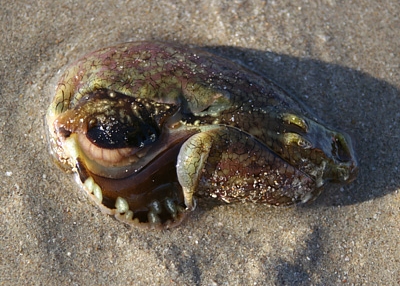Sea of Cortez Mystery Slug
April 4, 2007
From: Jennifer Beatty

Hi!
I'd like to know what tide-pool slug I happened upon last weekend in Peurto Penasco Mexico - in the north eastern area of the Sea of Cortez.
It was pretty stormy and windy before we got there and there were quite a few animals on the beach in the morning, including this curious slug that was on its last leg when I got to him. We gathered him up with some water and sand and returned him to a nice calm tide-pool.
When I found him he was rolled up , possibly a defense mechanism? The outside or underside was the green and purple, however when we put him in the water he had the two distinctive slug antenae in the front and two auxilliary just behind those for a total of four.
He also opened up a bit to expose his other skin which is the brown with purple spots. He was pretty big, about the size hot dog bun rolled up and after he opened up, it seems like he might have been roundish in shape , like the size of a small saucer.
Just curious what he was and some characteristics about him - also is he the poisonous type?
Locality: Peurto Penasco, in tide pool, Sonora, Mexico, Sea of Cortez, 24 March 2007, Washed up on Intertidal Beach. Length: 8 inches. Photographer: Jennifer Beatty.
Jennifer Beatty
jlbeatty22@gmail.com
Beatty, J.L., 2007 (Apr 4) Sea of Cortez Mystery Slug. [Message in] Sea Slug Forum. Australian Museum, Sydney. Available from http://www.seaslugforum.net/find/19781Hi Jenny,
The animal you came upon is what is commonly called the California sea hare, Aplysia californica. The frontal pair of distinctive antennae, as you refer to them, are the head tentacles and the second pair are where this group gets the name "sea hare." Presumably they look like rabbit ears. Actually these are the rhinophores, or sensory organs used as chemo-detectors, for locating the algae species these very large slugs feed on.
When your critter "opened up" its was folding its large parapodia (extensions of the mantle) exposing the mantle cavity and internal organs. Sea hares are known to use these parapodia to swim with by flapping them like a bird. You can see its gill in your photo. It is the white layered crescent below the almost black tissue situated in the center of the cavity. Have a look at the Sea Hares Fact Sheet for links to more information on these animals
The color pattern of green and purple mottling is characteristic of Aplysia californica.
Best wishes,
Dave Behrens
Related messages
-
Aplysia californica? from Peru
From: Leonidas Mulluhara, June 3, 2010 -
Re: Sea of Cortez Mystery Slug
From: Jennifer Beatty, April 5, 2007 -
Juvenile Californian Sea Hare & friends
From: Kevin Lee, December 12, 2006 -
Aplysia californica from California
From: Shannon Fabre, May 17, 2006 -
Aplysia californica from Sea Of Cortez
From: Gerald Hinkler, April 15, 2006 -
Aplysia californica at Puerto Penasco, Mexico?
From: Parker Tastrom, March 22, 2006 -
Juvenile Aplysia californica from Monterey, CA
From: Clinton Bauder, July 8, 2005 -
Can Aplysia californica eat kale?
From: John Lopez, March 5, 2005 -
Information on Aplysia californica
From: Michael Navarro, February 8, 2005 -
Aplysia californica from Santa Barbara Island
From: Chris Grossman , June 30, 2003 -
Re: Aplysia gigantea or A. californica?
From: Jun Imamoto, March 3, 2003 -
Aplysia californica inking
From: Bill Rudman, March 3, 2003 -
Aplysia gigantea? A. californica? from Japan
From: Jun Imamoto, February 5, 2003 -
Which slug is used for medical research?
From: John H. Garrett III, September 17, 2002 -
Keeping Aplysia in aquaria
From: Jessica Helm, August 29, 2001 -
Re: Keeping Aplysia in aquaria
From: Tom Capo , August 29, 2001 -
Photos of Aplysia californica
From: Daniel Geiger, August 1, 2001 -
Mass mortality of Aplysia californica
From: Jose Luis Ochoa, March 24, 2001 -
Sea Hare classification - A. californica
From: Rachel Frank, December 31, 2000 -
Aplysia for brain studies
From: Alvin Wong, September 2, 2000 -
Information on Aplysia californica
From: Luiza Zonzini, April 20, 2000 -
Re: HUGE Sea Hare
From: Ron Velarde, December 15, 1999 -
Re: HUGE Sea Hare
From: Diane, December 10, 1999 -
Is this a sea slug? It's HUGE!!
From: Diane, December 9, 1999 -
Sea Slugs from South California
From: Lonnie, July 13, 1999 -
re: Need to know what we saw
From: Eileen Steger, July 12, 1999 -
Re: Sea Hares - mating chains
From: Sigrid Schmalzer, July 12, 1999 -
Re: Sea Hares - mating chains
From: Sigrid Schmalzer, July 9, 1999 -
Need to Know what we saw
From: Eileen Steger, July 8, 1999 -
Photos of Aplysia californica
From: Daniel Geiger, March 12, 1999 -
Urechis caupa or Aplysia californica
From: barbara hansen, February 26, 1999 -
Aplysia californica algal preference
From: Christine Nguyen, January 3, 1999 -
Photo request for Aplysia californica
From: Panayotis Matsinopoulos, August 3, 1998
